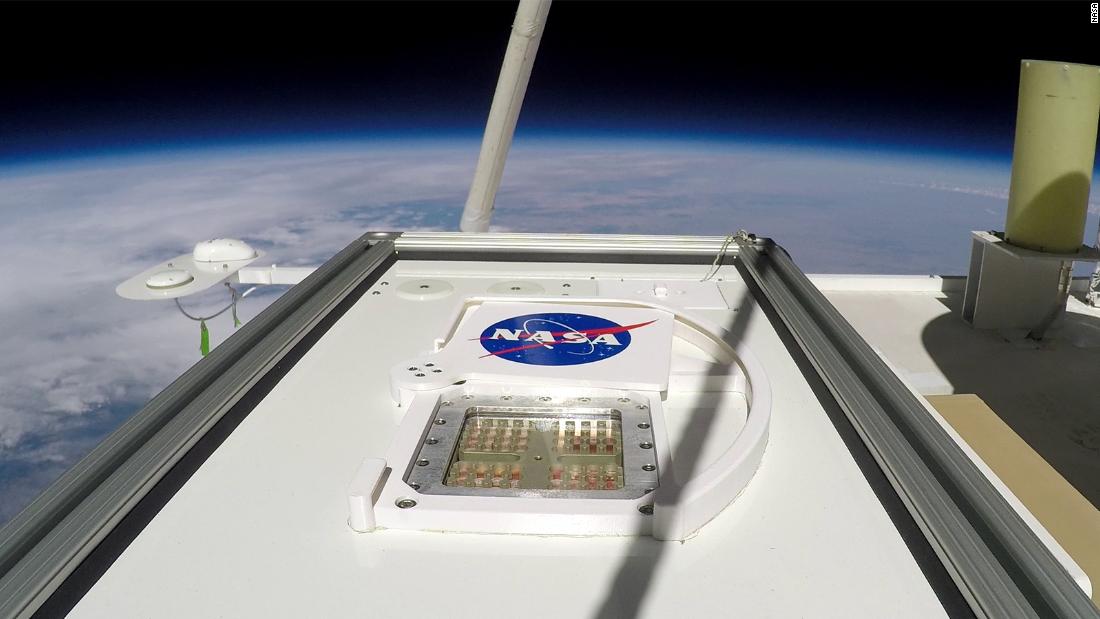
The two planets may not look very alike, but our stratosphere – a layer of the atmosphere 20 miles above Earth’s surface – has some features in common with Mars. Our home planet sThe tratosphere experiences low air pressure and a lot of radiation, and it is dry and cold – just like the surface of the red planet.
Using the MARSBOx, or the Microbes in Atmosphere for Radiation, Survival and Biological Outcomes Experiment, scientists from NASA and the German Aerospace Center collaborated to send four types of microbes in a balloon into the stratosphere.
“If a microbe can hack it there, above much of the protective ozone layer, it might survive – however brief – on a journey to the surface of Mars,” said study co-author David J. Smith, MARSBOx. co-principal investigator and investigator at NASA’s Ames Research Center, in a statement.
Microbes or microorganisms, have an enormous reach on Earth. It is estimated that there are 1 trillion species on our planet. They can also be found in harsh environments under varying extreme conditions.
NASA scientists need to know if these microbes can survive on Mars, sending robotic explorers to the red planet on behalf of humans. That’s why the mission teams behind these rovers, such as the recently landed Perseverance rover, take the cleanliness of these machines very seriously before launching them to Mars.
To test the likelihood of microbes surviving on Mars, the research team placed millions of microbes, including dried and dormant fungal and bacterial spores representing four types of microorganisms, on quartz discs. These discs were placed in aluminum boxes designed by the study staff at the German Aerospace Center.
A mixture of gases similar to those in the Martian atmosphere, which is dominated by carbon dioxide, was pumped into the boxes. A large science balloon containing the experiment was released from Fort Sumner, New Mexico on September 23, 2019.
Shutters were used to protect the microbes from the sun as they rise and fall. But once they reached Earth’s stratosphere, 25 miles away, the shutters opened and they were exposed to the harsh radiation there. The microbes were exposed to this for more than five hours, along with temperatures averaging 20 degrees Fahrenheit.
In the stratosphere, there is a thousand times less pressure than we experience at sea level, as well as very dry air.
When the experiment returned to the ground, the scientists determined that two of the four species survived the journey, proving that these two could temporarily withstand the harsh conditions of Earth’s stratosphere and possibly the surface of Mars.
“This research gives us a better understanding of which microbes can linger in environments once considered deadly, such as the surface of Mars, and gives us clues on how to avoid accidentally taking small hitchhikers to destinations outside the world. study co-author Ralf Moeller, MARSBOx co-principal investigator and head of the Aerospace Microbiology Research Group at Germany’s Aerospace Center, said in a statement.
Surviving species included Staphylococcus capitis and Salinisphaera shabanensis. The first is a bacteria associated with human skin and the second is a bacteria that can be found in deep-water brine baths.
Aspergillus niger, a fungus used in antibiotic production, was dried to send it to the experiment, and it could also be revived when it returned from Earth’s stratosphere.
“Spores from the A. niger fungus are incredibly resistant – to heat, harsh chemicals and other stressors – but no one had ever investigated whether they could survive in space or under intense radiation like we see on Mars,” said co-leader study author Marta Cortesão, a doctoral student at the Aerospace Microbiology Research Group of the German Aerospace Center, said in a statement.
“The fact that we were able to revive them after their MARSBOx flight shows that they are tough enough to survive wherever humans go, even off the planet.”
It is possible that Aspergillus niger has a sunscreen-like pigmentation or a cellular structure that protects itself.
“This experiment raises a lot of questions about what genetic mechanisms are key for microbes to survive,” said Cortesão. “Do they carry ancient evolutionary traits that enable them to withstand harsh conditions, or does adaptation to their current environment protect against many other environmental challenges?”
Future research could help scientists better determine why these microbes survived. A follow-up flight is planned for MARSBOx in Antarctica, where both solar and galactic cosmic rays from space resemble Mars even more.
“These balloon aerobiology experiments allow us to study the microbe’s resilience in ways that are impossible in the lab,” said Smith. “MARSBOx provides the ability to predict survival outcomes on Mars and help define the boundaries of life as we know it.”
In the meantime, these findings could help plan future missions to Mars. “The renewed focus on Mars robotics and human exploration increases the need for additional Mars analog studies in the coming years,” the authors wrote in the study.
“With long-term manned missions to Mars, we need to know how human-associated microorganisms would survive on the Red Planet, as some could pose a health risk to astronauts,” said co-lead researcher Katharina Siems, a doctoral student in the Aerospace Microbiology Research Group. from the German Aerospace Center, in a statement.
“In addition, some microbes can be invaluable for space exploration. They can help us produce food and material supplies independently of Earth, which will be crucial when we are far from home. Microorganisms are closely linked to us. our bodies, our food, our environment, so it’s impossible to exclude them from space travel. “




